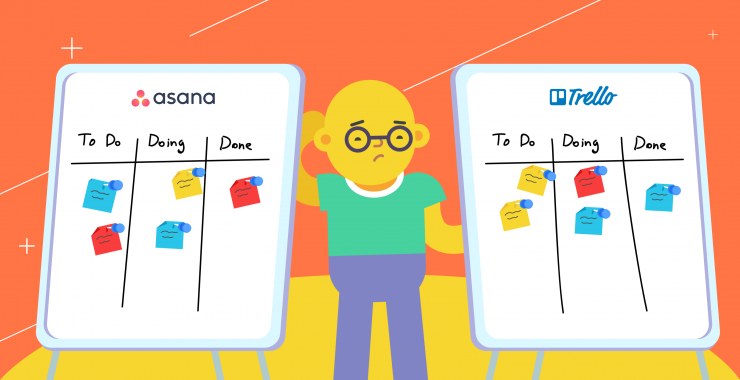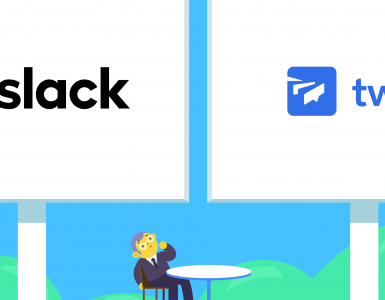So, do you consider using Asana or Trello as project management tools? If you’re on the fence, you’ve come to the right place. This review will assist you in making the best choice. Welcome!
At Chanty, we love exploring different tools. Learning about the pros and cons of different apps helps us make our own team chat. In our reviews, we usually look at Slack alternatives. However, as we’ve designed a built-in task manager for Chanty, we became keen on some great project management tools, like Trello and Asana, which resulted in this review.
For the record, whatever app you choose, our team chat can be a great addition to it, providing a place to discuss and keep you updated with project details. Give Chanty a try!
Both Asana and Trello have numerous features that can’t be covered in a single article. (Maybe a book would do it.) So we focused only on the most important features to help you choose the app that is right for you. If you don’t have time for an in-depth review, scroll down to the summary of the main differences between the tools. Have a read!
Asana vs. Trello: some stories to tell
Asana and Trello entered the tech world nearly at the same time.
Announced in September 2011, Trello presented the “kanban board” approach. Put simply, you can drag and drop cards in the app like you’d move sticky notes on a whiteboard. Later, Asana adopted the idea too, giving Trello full credit.
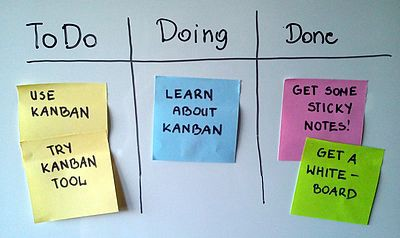 Kanban method
Kanban method
Here’s how Trello’s user interface looked in 2011. You might notice it’s somewhat similar to the most recent version.
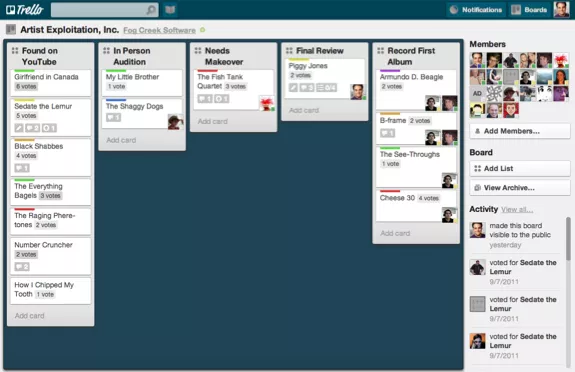 Trello back in 2011
Trello back in 2011
Image source
Asana was unveiled just two months after Trello by Facebook co-founder Dustin Moskovitz. This is how the tool looked back then. (The UI changed quite a lot!).
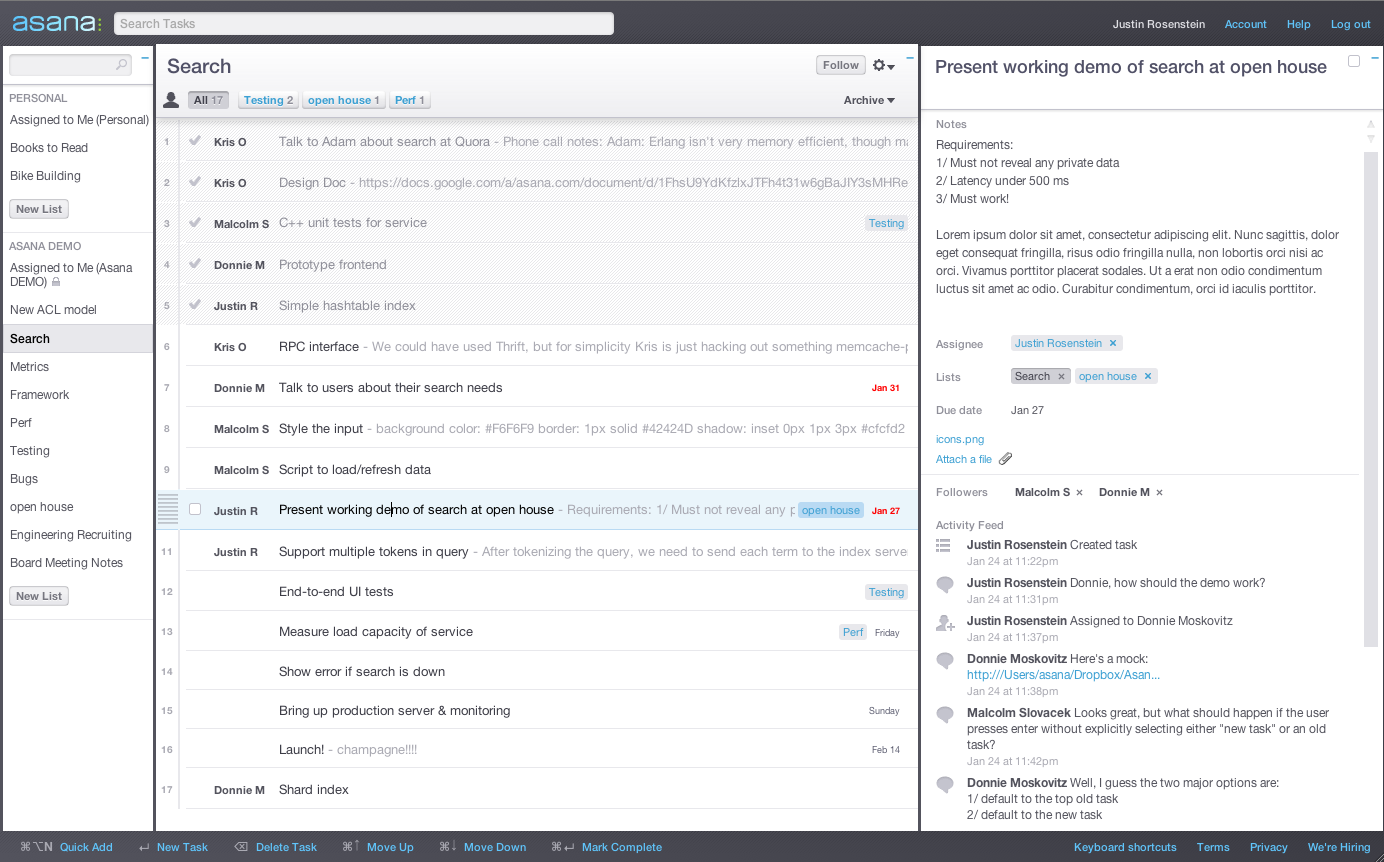 Asana interface in 2011
Asana interface in 2011
Image source
Anyway, both tools have enjoyed quite a success, though Trello acquired bigger popularity. In 2016, the tool hit a milestone passing 1 million daily active users. A year later after acquisition by Atlassian, it continued growing. Now Trello has 1 million teams actively using the service.
Asana is much smaller than many of its public company competitors including Atlassian. But its founder brushes aside any competitive fears and celebrates steady progress. In 2018, Asana boasted 50,000 paying organizations.
My guess is that Trello’s numbers are bigger partly because it’s designed not only for business. Its landing page says: ‘create boards for everything in your life.’ Although, Trello has been moving to bigger enterprises lately. Asana seemed to be more business–focused from the very beginning pitching itself as a ‘work management platform for teams.’
Asana vs. Trello: pricing
As you can see, the pricing of the tools is very similar, though in the early 2019 Asana had a cheaper plan for small teams which was $6.25 per member, per month.
Please be aware that the current pricing details are valid as of June 2019.
| Asana pricing | Trello pricing |
| Basic $0.00Premium $10.99/user/month (billed annually) or 13.49/user/month (billed monthly)Business $24.99/user/month (billed annually), or $30.49/user/month (billed monthly) | Free $0.00Standard $5/user/month (billed annually), or $6/user/month (billed monthly)Premium $10/user/month (billed annually), or $12.50/user/month (billed monthly) Enterprise $17.50/user/month (billed annually only) |
As you can see, when it comes to pricing, there’s not exactly a clear winner between the tools.
Asana vs. Trello: a quick review
We’ll discuss the pros and cons of both tools in a moment. Here’s a short table to kick off the comparison.
| Asana | Trello | |
| Key features | Projects, lists, tasks | Boards, lists, cards |
| Board view | Yes | Yes |
| List view | Yes | No |
| Calendar view | Yes | Via power-up (integration) |
| Timeline | Yes (in paid plans) | Via Power-up (integration) |
| Key limitation in the Freemium plan | Up to 15 team members | Up to 10 Team Boards, unlimited Power-Up per board |
| Integrations | 200+ | 200+ |
Now, let’s dive into some details.
Asana vs. Trello: user interface
Though the design and UI of both tools differ, their layout is somewhat similar.
There is a smaller panel on the left, the bigger on the right and an upper one for search, profile settings, and some other features.
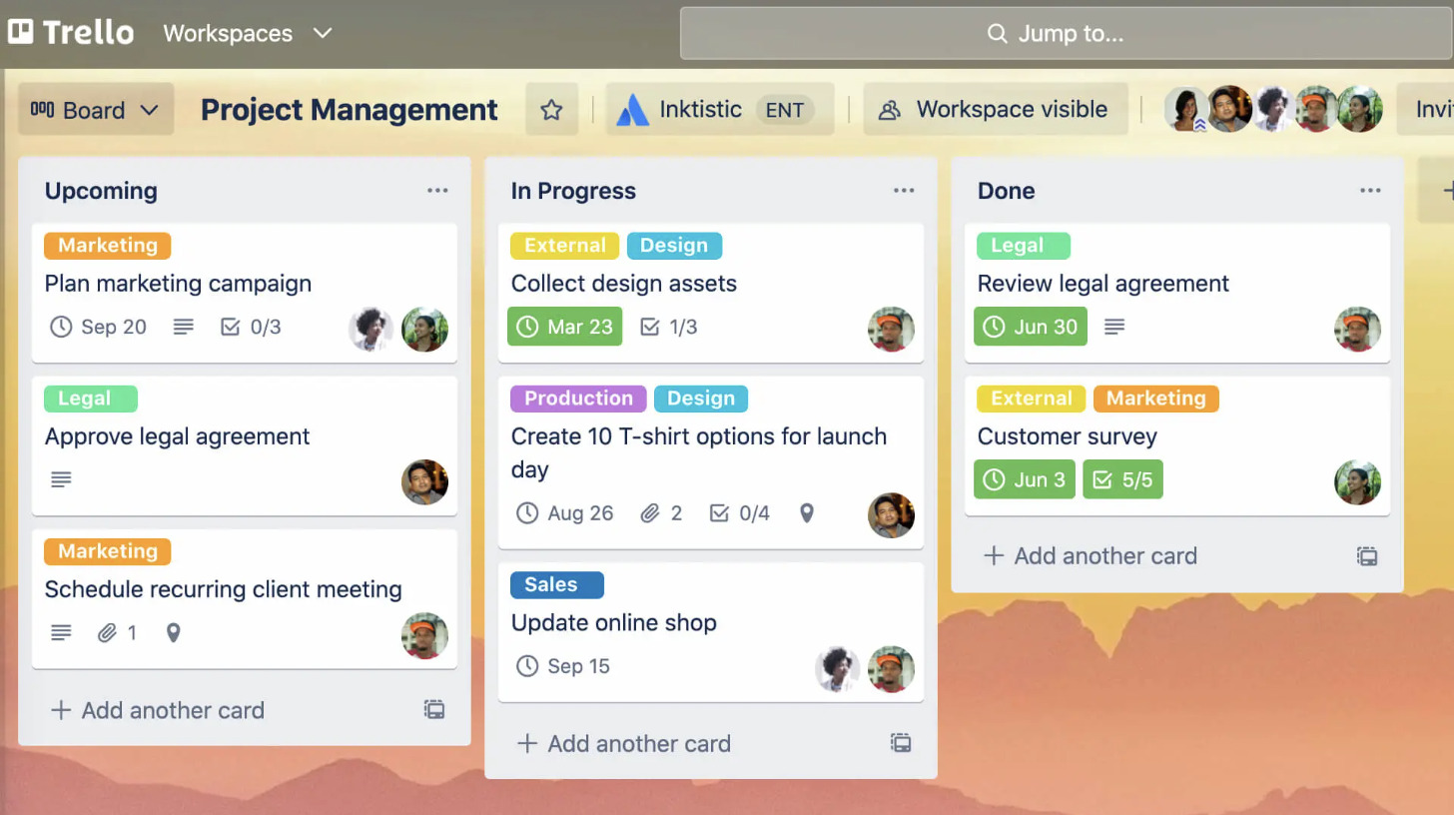
Trello user interface
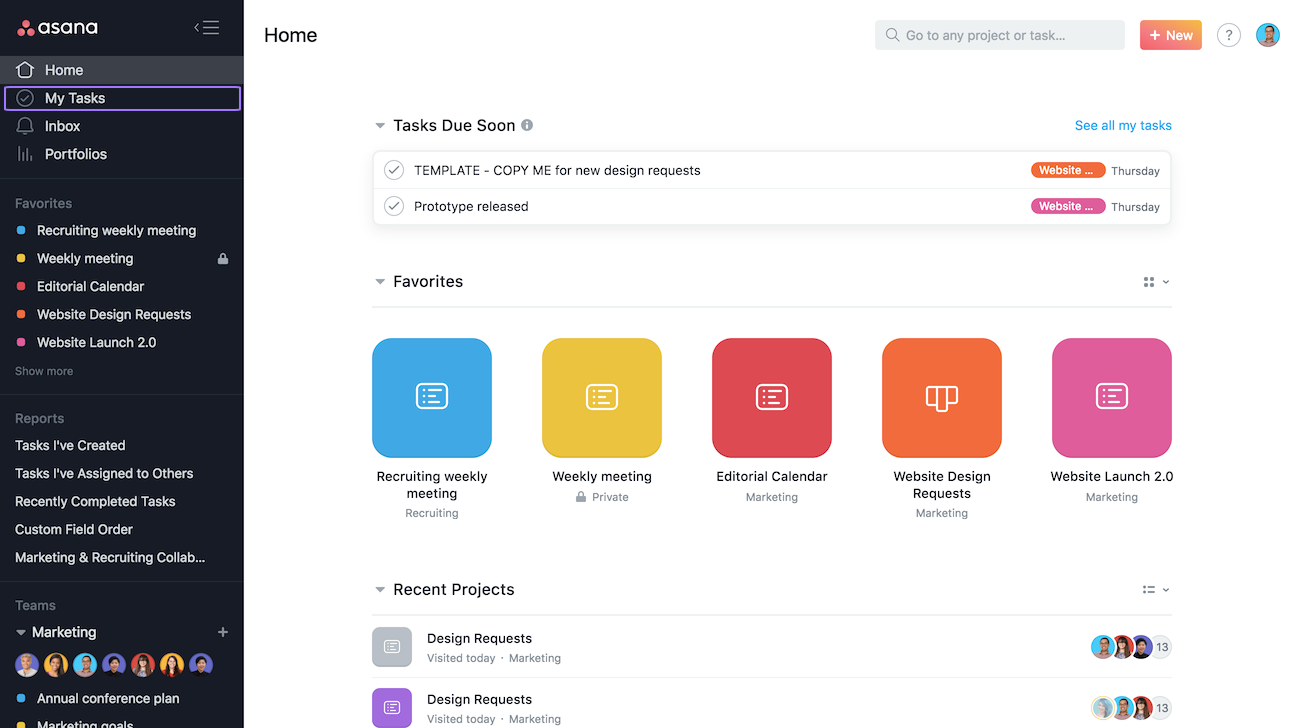
Asana user interface
Correct me if I’m wrong, but Trello seems more compact in wrapping up features. Its user interface looks minimalistic with only ‘Boards’, ‘Home’ and ‘Teams’ tabs.
In Asana, many more tabs like ‘Inbox’ and ‘Portfolios’ come up right after signing in. I remember it confused me a bit when I first explored the tool. However, I’m sure that devoted Asana users totally accept and praise the tool’s UI.
Now, in what way can we adjust the tools for our needs?
Asana vs. Trello: customization
In Trello, you can change your Boards’ background by choosing a specific colour or any other customized picture.
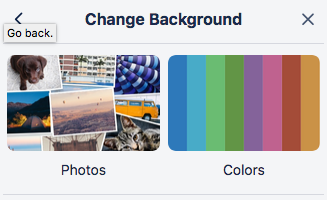 Changing Background of a Trello board
Changing Background of a Trello board
In Asana, you can change the background for your profile, but not for a particular project (at least using Freemium plan).
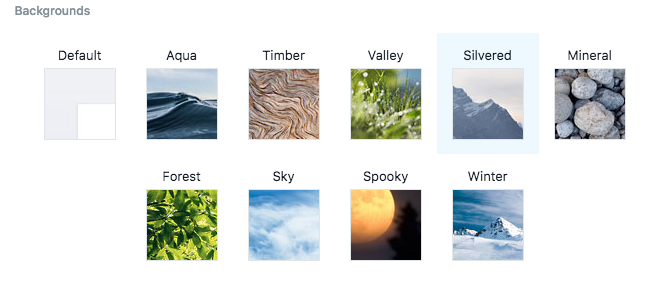 Choosing your profile background in Asana
Choosing your profile background in Asana
For projects in Asana, you can set highlight colors.
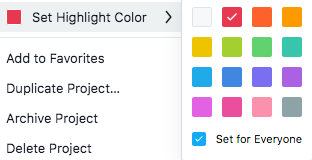
Choosing highlight color in Asana
When it comes to language support, Trello is available in over 21 languages, Asana – in 13 languages.
Asana vs. Trello: basics
Before we talk about distinctions, let’s briefly review the key functionality of the tools for those unfamiliar with it. It might help us to better understand the differences.
If you already know the ropes when it comes to Asana or Trello, you can scroll down to the next section: ‘3 basic differences in features.’
Trello
So, what would you typically do after signing up to Trello?
1. Create a Board
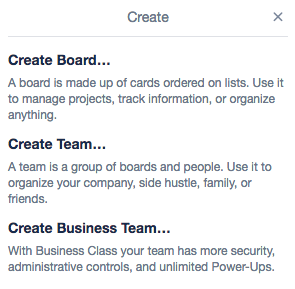 Creating a Board in Trello
Creating a Board in Trello
Board is a key concept in Trello. Any task can be assigned within a board only. Without creating a board, you won’t do much in Trello. It can be your project, e.g. a marketing plan or someone’s party, with items and tasks to perform and check. Boards can be private or public.
2. Create Lists
Once you created a board, you can set up lists. These are basically columns between which you move your cards (tasks and to do’s). Very often users create three lists named ‘To do,’ ‘Doing’ and ‘Done.’
 Creating lists in Trello
Creating lists in Trello
You can drag and drop cards from one column to another until a task is completed.
3. Add a card
After creating a board and lists you can finally create a card. It might be your task or a to-do.
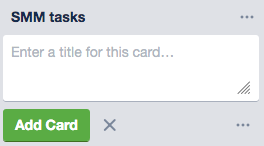 Adding a card in Trello
Adding a card in Trello
4. Specify a card
Now, you can assign this task to anyone, add due date, description or comments, attachments, checklists, etc.
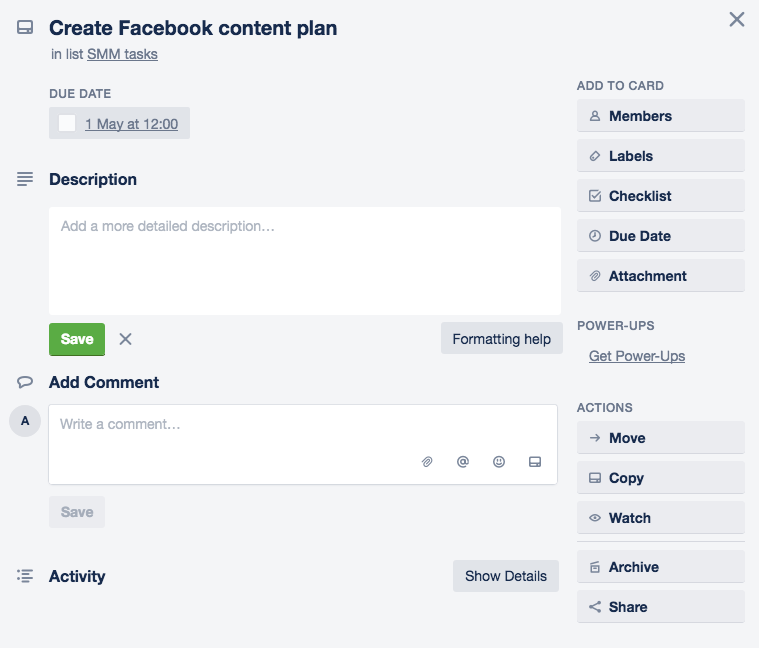 That’s actually it – the main functionality of Trello
That’s actually it – the main functionality of Trello
Now, let’s turn to Asana. What do you start with after signing up?
Asana
1. Add a task
If in Trello you need to create a board first to add a card, in Asana you can create a task right away.
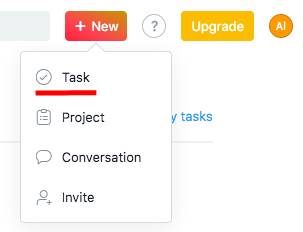
Creating a task in Asana
The task will appear in ‘My Tasks’ tab. You can add it to a particular project anytime, though.
2. Specify a task
After designing a task, you can add any details, comments and files to it, create a checklist and many more.
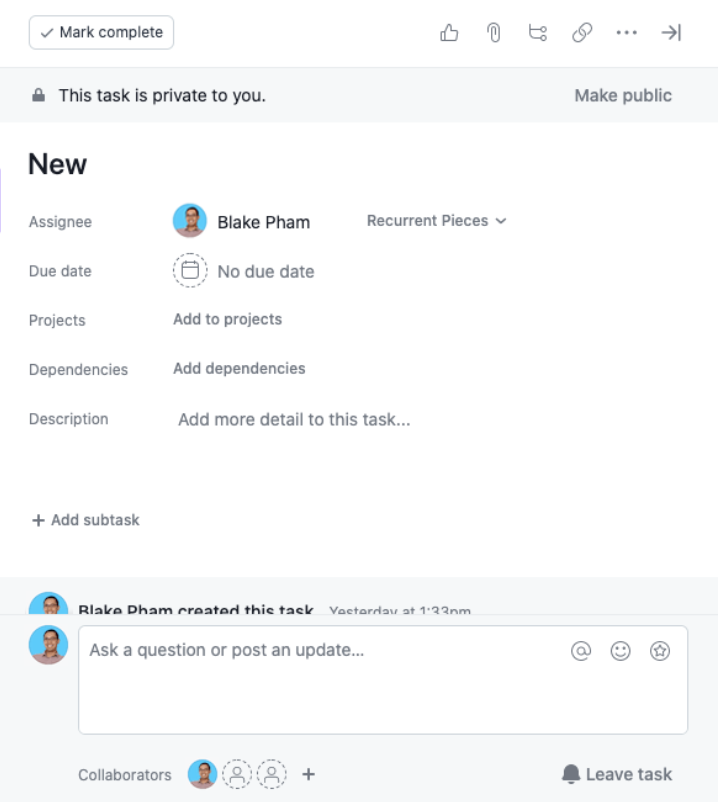
Specifying your task in Asana
3. Create a project
By creating a project you organize your tasks related to a specific initiative or goal. At this stage, you can choose the layout – list or board view – and set up the privacy settings for a project
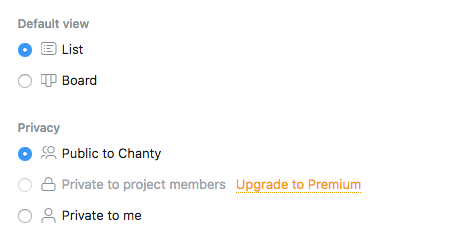 Creating a project in Asana
Creating a project in Asana
4. Add or rename columns
If you choose a board view, ‘To do’, ‘Doing’ and ‘Done’ columns will be set up automatically.
Though you can always rename them or add other columns.
 Columns in Asana
Columns in Asana
Well, that’s the very basics of Asana!
Now, since we know the ropes, let’s move on to the main differences between the tools.
Asana vs. Trello: 3 basic differences in features
1. By default, only board view is available in Trello. Asana comes with both board and a list view out of the box.
Trello is a solid visual tool that has done a great job with Kanban boards. So if the virtual sticky notes satisfy your needs, you can just go with them. But, sometimes, Board view might not work well. For example, if you get a scrum call and need to go quickly through a list of the open questions from a client. Or maybe you just like making lists? Then Asana might be the more reasonable choice, as it provides not only Board but also List view for your tasks.
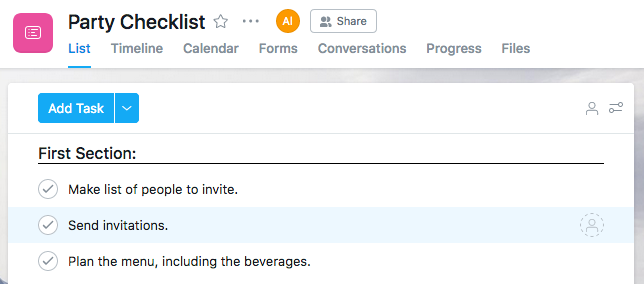 List view in Asana
List view in Asana
Sidenote: In Trello, you can view tasks in so-called Tree view (via integration), which is similar to List view. At the same time, in Asana, you can also choose Timeline (in paid plans) and Calendar view. We’ll talk about this below.
2. Freemium plan: Asana limits number of users, Trello restricts the number of Team Boards and Power-Ups
There are also some differences in Freemium version of the tool. Here’s the crucial one. Asana puts limits on the number of teammates you collaborate with – up to 15 in the Freemium plan.
Trello doesn’t restrict the number of members, however imposing a restriction on the number of Team Boards – up to 10 in the Freemium plan. Of course, you can still create unlimited personal boards, although collaborating on them with your colleagues might be disruptive for your workflow. (You have to invite all of them each time you create a board).
If you have a team up to 15 members, Freemium plan of Asana could be your choice. If you have a bigger team but up to 10 projects and you don’t need to use integrations much, Freemium plan of Trello might suit you. Otherwise, you need to choose paid plans.
3. Asana has more built-in features (though many of them paid), while in Trello you might use Power-Ups quite often to expand your capabilities.
In a word, Asana relies more on built-in features, while Trello – on Power-Ups. Here are two examples to justify this point.
1. As mentioned, Asana has Calendar view, which allows you to see your tasks in the context of particular days and weeks.
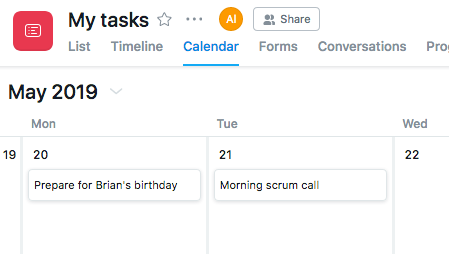 Calendar view in Asana
Calendar view in Asana
In Trello, you have no choice but to use a Power-Up to get the calendar view. Here’s how it will look like.
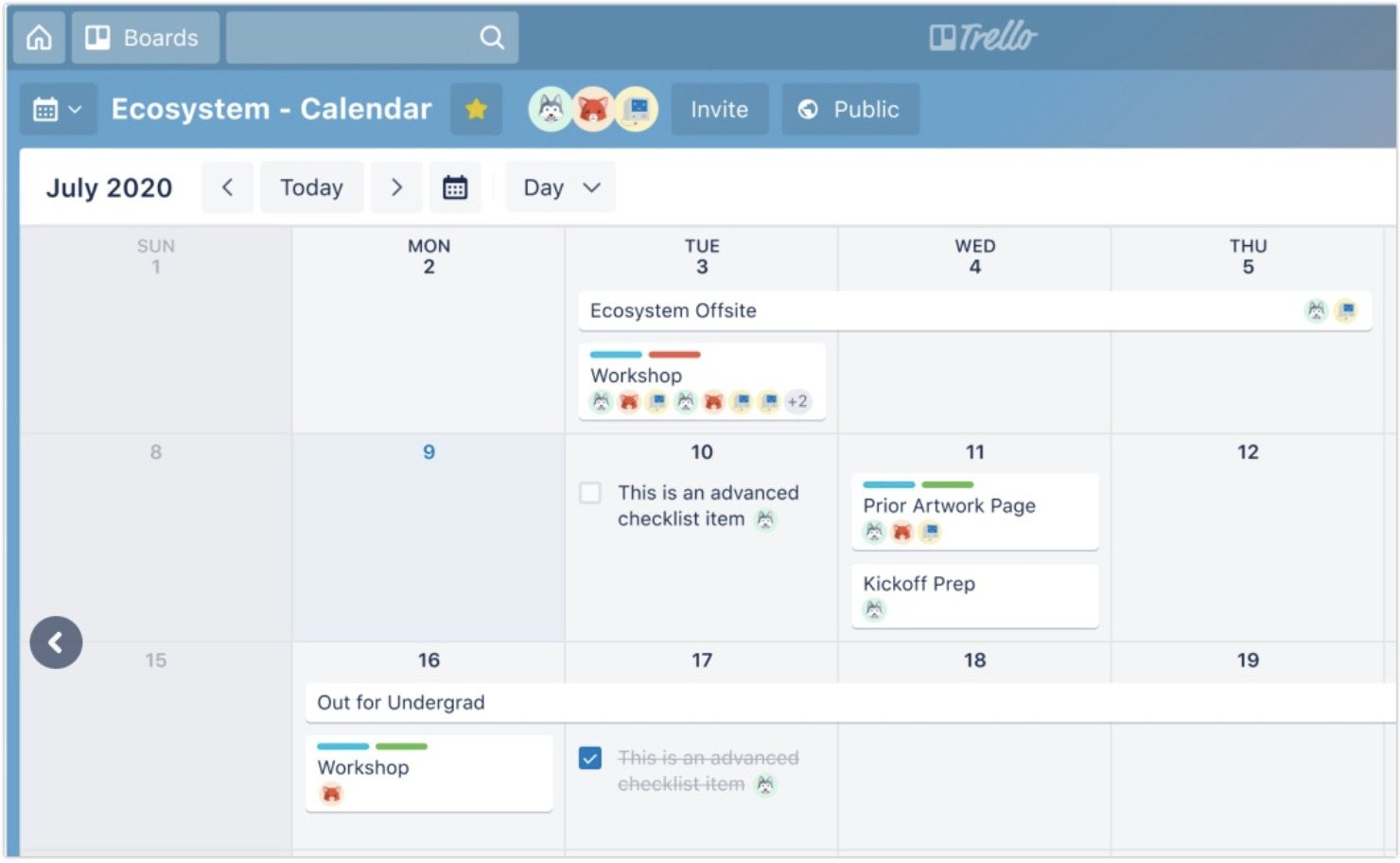
Using Calendar Power-Up in Trello
2. Here’s another—Timeline feature—which is important for dependency management. It allows you to specify which tasks need to be done before others can begin. Once again, Timeline is built-in (though paid in Asana). In Trello, you would need an integration that lets you visually manage your projects.
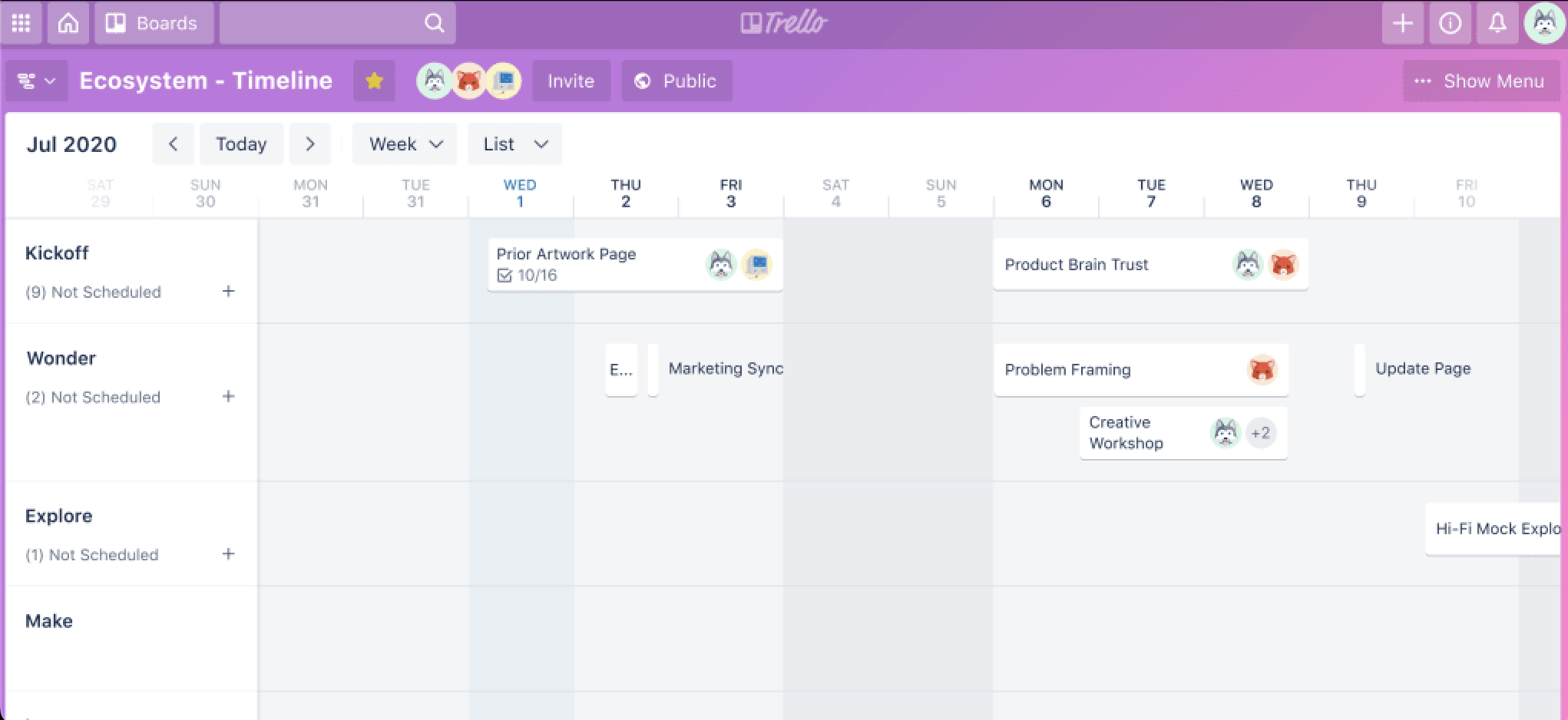
Timeline in Trello
Image source
Asana vs Trello: communication
Neither of the tools provides direct messaging, or built-in audio/video calls. Still, both tools provide some means of communication.
Asana has so-called Conversations feature available within Teams and Projects. This is a space where you can chat and exchange comments with your colleagues.
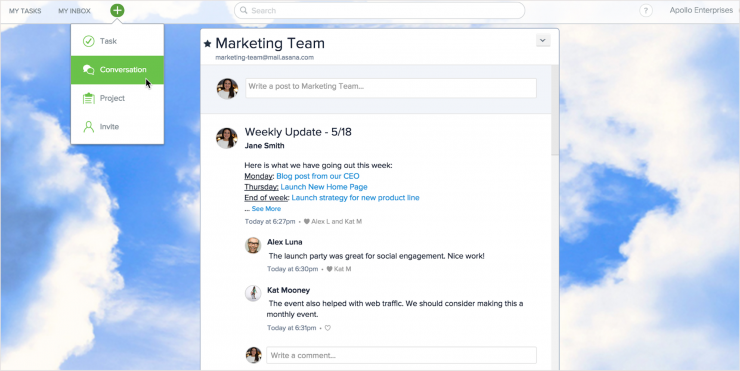 Conversations in Asana
Conversations in Asana
Image source
Also, you can comment on specific Tasks and Cards in Asana using @mentions. Finally, you can create a particular project for conversations and use it as a private chat in Asana. We described this trick in our Asana vs Slack article.
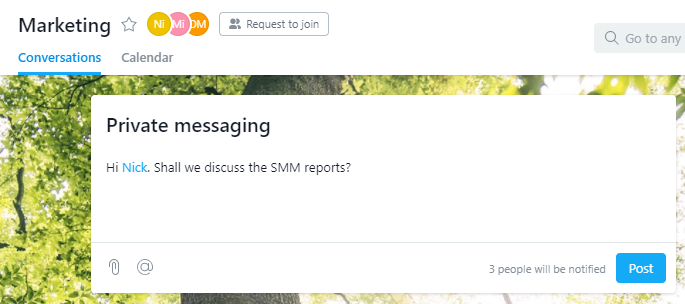 Exchanging private messages in Asana
Exchanging private messages in Asana
In Trello, your communication is somewhat limited to commenting to Cards.
Having Conversations and some other features, Asana provides more means of communication than Trello. Any of these tools, however, can’t replace a team chat featuring specific channels for conversations, direct messages, audio and video calls, etc. That’s why connecting a PM tool with a smart communication app can boost up your productivity. Sign up to try out Chanty team chat for your deadline-driven team!
Asana vs Trello: collaboration and some advanced features
Both tools have dozens of advanced features, which are impossible to explore in a single article. So, I’ll highlight just a couple of them.
Being the PM tools, Asana and Trello are designed for collaboration. So you can freely assign your tasks to colleagues and keep track of them. The notification settings can be set and adjusted according to your needs.
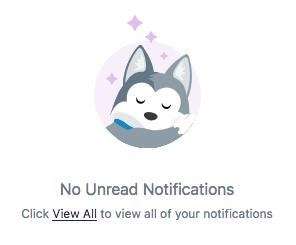 Notification box in Trello
Notification box in Trello
Also, you can do a bunch of stuff to the tasks/cards you create. For example, add checklist items (Trello) or subtasks (Asana) to specify your to-do’s. Or copy a task link (Asana) or board link (Trello) to make it available to anyone on the web.
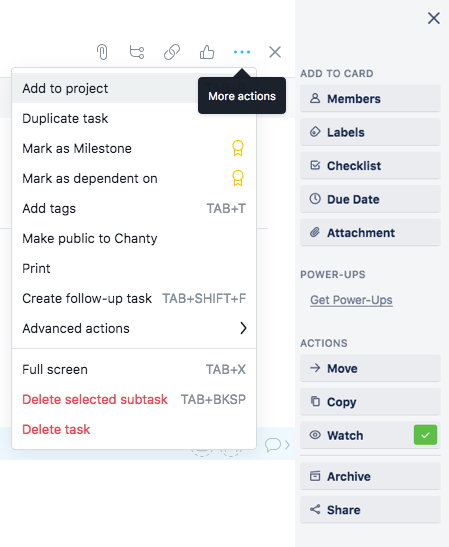 Some things you can do with tasks/cards in Asana/Trello
Some things you can do with tasks/cards in Asana/Trello
In Asana, you can also ‘like’ a particular task. (I didn’t find this feature in Trello). In Asana’s paid plans, you can add so called Milestones and create task dependencies.
Both tools have numerous advanced features. It’s impossible to cover all of them in one article, so if you want us to review something specific – feel free to leave a comment with your request.
Asana vs Trello: file sharing
In both tools, you can add files to cards (Trello) or tasks (Asana). There are file upload limits, though.
It’s no use to attach a file larger than 10MB if you have Trello Freemium plan. In paid plans, however, the limit is lifted up to 250MB.
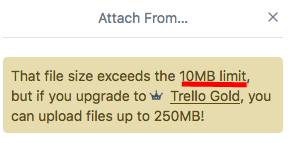
In Asana, the limit is 100MB per file limit for files from your computer no matter whether you pay for the tool.
 Notification about file upload limit in Asana
Notification about file upload limit in Asana
But it’s probably a good idea to use the integration with file management tools, like Dropbox or Google Drive, available in both apps.
If using Freemium plans, Asana has a larger file upload limit. In paid plans, Trello is ahead of the pack. Integrations with file management tools are available in both apps.
Asana vs Trello: filter and search
I tested basic search in both tools and it worked great.
I was able to find any card (Trello) or task (Asana), a phrase in a description, comment or conversation.
 Search in Asana a phrase in a task description
Search in Asana a phrase in a task description
However, when it comes to some advanced search features, there’s a difference between the tools. To refine your search in Asana, to find tasks with a specific due date or search through uncompleted tasks only, you have to be a user of Asana’s paid plan.
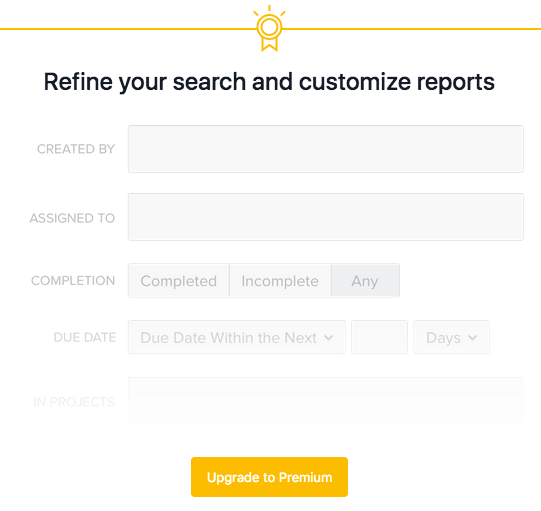 Asana’s advanced search is not available until you pay
Asana’s advanced search is not available until you pay
In Trello, however, the advanced search features are available in the Freemium plan. You can specify your search by using search operators. I used ‘due:week’ to find a task due in the next 7 days.
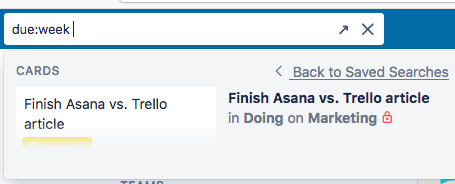 Search in Trello
Search in Trello
Some advanced search features are available for free in Trello, but you’d have to pay for using most of them in Asana.
Asana vs Trello: integrations
As mentioned, both tools integrate with third-party apps, while Trello relies on integrations quite heavily. The app has 200+ Power-Ups, and Asana connects with 200+ tools as of Jan 2023.
Since both apps are well-known and widely used, lots of tools are building integrations with them. E.g. our Chanty team chat connects to either of the apps. This allows to get notifications about any changes in your projects, cards or lists to a specific channel.
 Receiving Trello notifications in Chanty
Receiving Trello notifications in Chanty
There’s also an option to easily connect both of the tools via Zapier.
As for integrations limit, I didn’t find any information about it in Asana, while in Trello only 1 Power-Up per Board is available on Freemium plan.
Asana vs. Trello: wrapping up
Both – Asana and Trello – are solid project management tools with numerous and diverse features. Their pricing is quite similar, while both apps also provide Freemium plans.
When choosing between Asana and Trello, consider the following:
Tasks view. Only Board view is available in Trello out of the box (although Tree view is available via the integration); Asana also provides List view.
Freemium plan limitations. Asana is available for teams up to 15 people only. Trello limits the number of Team Boards to 10.
Integrations. Trello relies on integrations heavily, while Asana has more built-in features. (though some of them are paid). Trello has 200+ integrations and same as Asana’s 200+.
Communication. Asana has more means of communication than Trello providing Conversation feature. Though, it’s a good idea to utilize either of the tools with a smart team chat.
File management. In paid plans, Trello has a larger file upload limit (250MB) compared to Asana (100MB). Though, integrations with file management tools are provided.
Search. Basic search works great in both tools. The advanced search features in Asana are paid, while Trello provides the more detailed search for free.
So, these are some basic points. Hope they helped! Here’s one last thing.
If you need a simple and easy-to-use tool to work with tasks and to-dos, maybe a multi-functional PM app won’t be the best solution. Instead, you might consider using a smart team chat with a built-in task manager.
Chanty allows you to create a task out of any message with a click of a button, discuss, assign and reassign your to-dos. It’s very intuitive, so you don’t have to spend tons of time learning the ropes.
In case you still decide to use a certain PM app, you can integrate it with Chanty for better team productivity. Book the demo with us to learn more!
I wonder what’s your take on Asana vs Trello? Share your thoughts in the comments.



